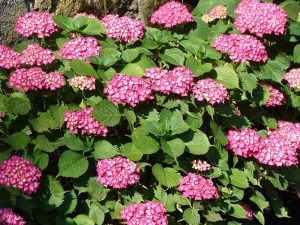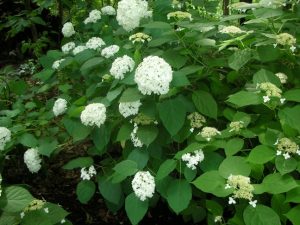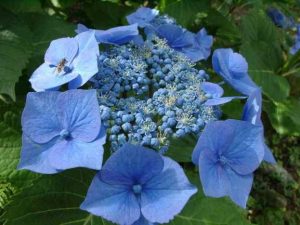Hydrangeas are popular, but understandably confusing! There are about 25 species, though only five are primarily grown in the U.S. There are literally thousands of cultivars. Some species are classified as either mophead (all large, sterile florets) or lacecap (fertile, center florets surrounded by larger, sterile florets), depending on cultivar. The showiest part of the flower cluster is actually the bracts rather than petals. The bracts persist long after the petals drop and are often cut for dried floral arrangements.
Initiation of flower buds and when to prune
-Some hydrangeas bloom only on old wood (last-year’s growth); prune after bloom.
-Some bloom only on new wood (current season’s growth); prune late winter.
-A few bloom primarily on old wood but can also bloom on new wood.
Hydrangea species
Smooth hydrangea (H. arborescens)
Native species features large clusters of pale, greenish blooms, changing to white and then drying to papery brown; blooms on new wood. Often best to prune back to a few inches in late winter for sturdier stems.
Annabelle – huge blooms, very showy and popular
Incrediball – larger blooms than Annabelle!
Invincebelle Spirit – pink flowers, breast cancer fundraiser
White Dome – lacecap form
Oakleaf hydrangea (H. quercifolia)
A dramatic native species, foliage is shaped like an oak leaf, with outstanding fall color; cinnamon-brown, peeling bark visible in winter. Showy blooms in late spring and early summer; blooms on old wood. It is generally a large, coarse shrub, though some compact cultivars are available. Prune, if needed, after blooming.
Alice – Large, white flowers maturing to a rose pink; outstanding purple color in fall
Snow Queen – Upright, white flower clusters maturing to pink, burgundy fall foliage Little Honey – Compact plant with yellow foliage in spring, chartreuse in summer, changing to red in fall
Pee Wee – Compact shrub, white flowers turn pink, red fall color
Snowflake – Large, double white flowers maturing to purple-pink, burgundy fall foliage
Panicle hydrangea (H. paniculata)
Large shrub, native to Asia, most with cone-shaped clusters of white flowers; blooms mid-summer on new wood, can prune end of winter.
Bobo – dwarf Pee Gee type, large cone of white blooms, may fade to pink
Grandiflora aka Pee Gee (PG) – huge cone of white blooms changing to pink
Limelight – lime green flowers changing to greenish-white to pink
Little Lamb – small, white florets on compact shrub
Pinky Winky – white flowers changing to deep pink
Bigleaf Hydrangea (H. macrophylla)
This most popular species is native to Japan, but most selections bloom only on old wood and foliage usually is killed to the ground in Zone 5, frequently in Zone 6. A few cultivars will also bloom on new wood (remontant) but are showiest on old wood. Flowers are blue in acidic soil, pink in alkaline soil (availability of aluminum is the key factor which is related to soil pH.) If your hydrangea never blooms but produces lovely foliage every year, it is likely this species and flower buds were winter killed.
Selected Remontant Cultivars (can bloom on new wood):
‘All Summer Beauty’
‘Blushing Bride’
‘Dave Ramsey’
‘Endless Summer’
‘Lemon Wave’ Variegated foliage attractive even without blooms.
‘Penny Mac’
Mountain Hydrangea (H. serrata) (a.k.a H. macrophylla var. serrata)
Flower buds hardier and earlier than bigleaf but more demanding of cool, moist soil.
‘Tiny Tuff Stuff’ Compact form of ‘Tuff Stuff’.
‘Tuff Stuff’ Reblooming lacecap type, blooms can be pink, blue or white (based on soil pH)
Climbing Hydrangea, (H. anomala petiolaris)
Also native to Asia, this striking clinging vine (root-like fastholds) with fragrant, lacecap flowers on current season’s growth and has interesting cinnamon, peeling bark. Needs sturdy support. Hydrangea-vine is a separate but related genus (Schizophragma spp.).
‘Skyland’s Giant’ has large white flower clusters.
‘Firefly’ has variegated foliage of green and bright yellow in spring but less contrasting as foliage matures.



